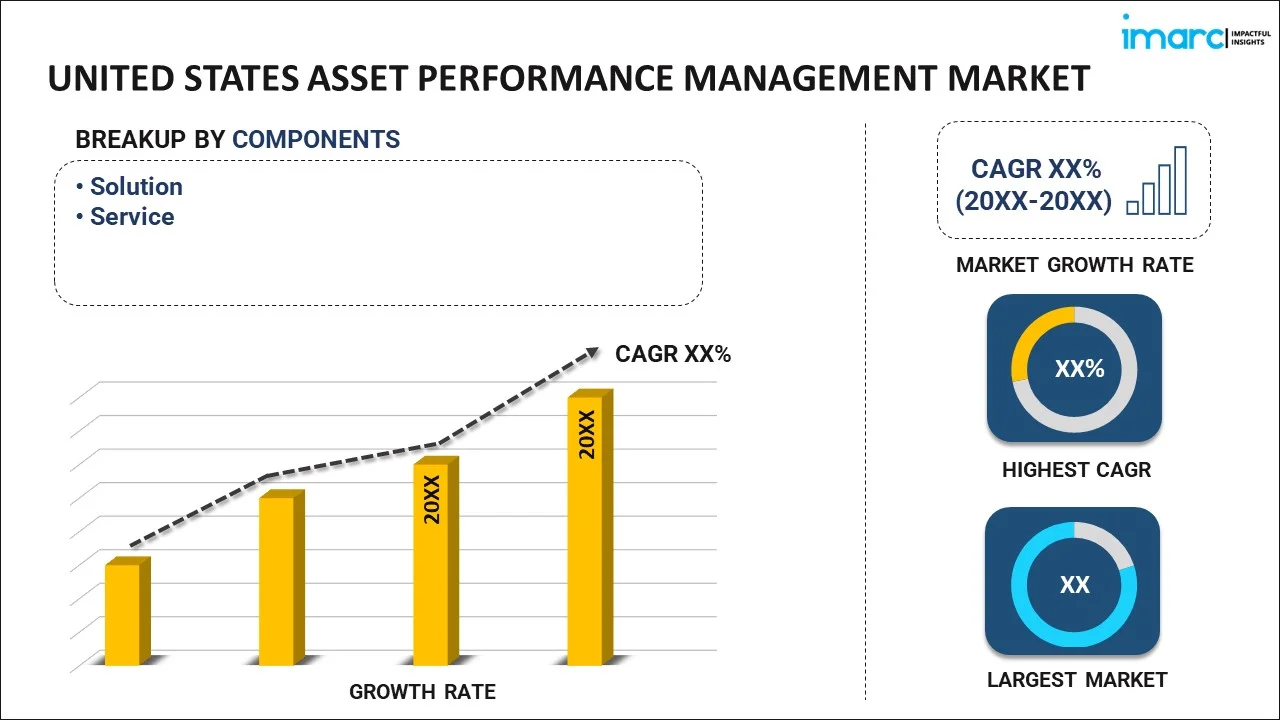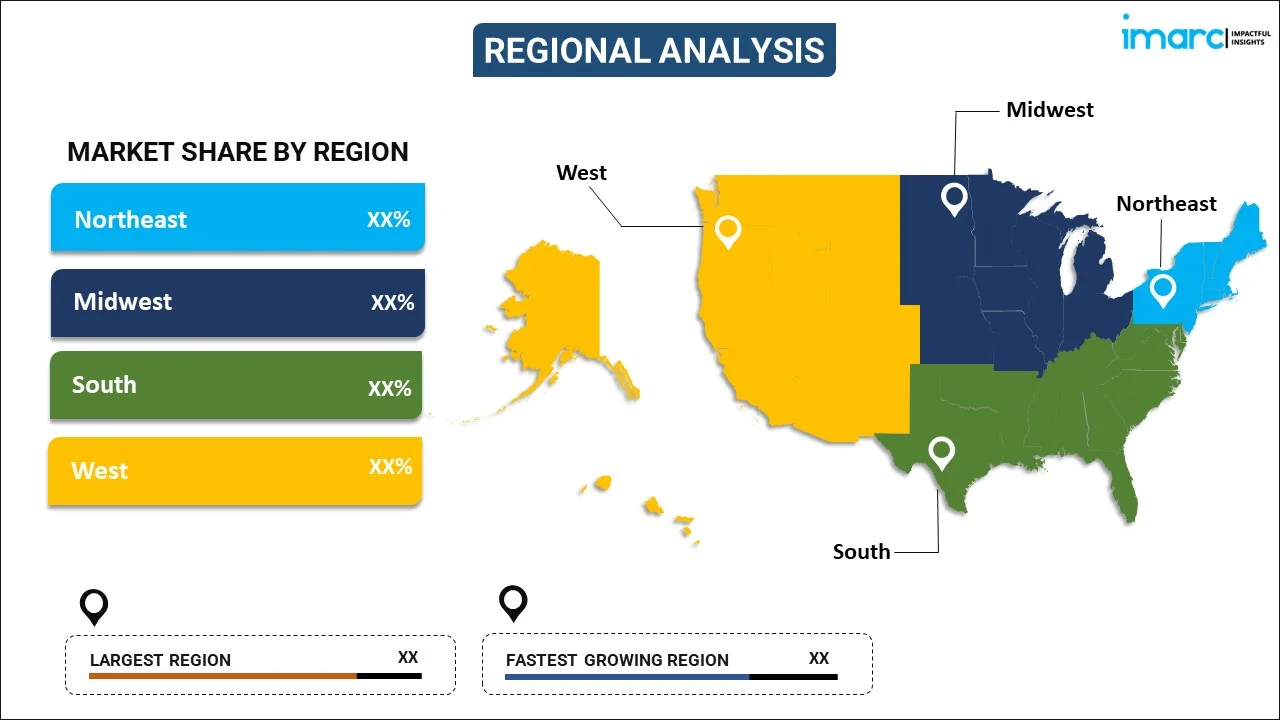
United States Asset Performance Management Market Report by Component (Solution, Service), Deployment Mode (On-premises, Cloud-based), Organization Size (Large Enterprises, Small and Medium-sized Enterprises), Industry Vertical (Energy and Utilities, Oil and Gas, Manufacturing, Mining and Metals, Healthcare and Life Sciences, Chemical and Pharmaceuticals, Government and Defense, IT and Telecom, Food and Beverages, and Others), and Region 2025-2033
Market Overview:
United States asset performance management market size reached USD 6.7 Billion in 2024. Looking forward, IMARC Group expects the market to reach USD 16.3 Billion by 2033, exhibiting a growth rate (CAGR) of 9.1% during 2025-2033. The increasing adoption of cloud-based asset performance management solutions, which allows organizations to access and analyze data from anywhere, streamline collaboration, and benefit from the scalability and flexibility offered by cloud platforms, is driving the market.
|
Report Attribute
|
Key Statistics
|
|---|---|
|
Base Year
|
2024
|
|
Forecast Years
|
2025-2033
|
|
Historical Years
|
2019-2024
|
|
Market Size in 2024
|
USD 6.7 Billion |
|
Market Forecast in 2033
|
USD 16.3 Billion |
| Market Growth Rate 2025-2033 | 9.1% |
Asset performance management (APM) is a holistic approach to optimizing the efficiency and reliability of physical assets within an organization. It integrates advanced technologies such as IoT sensors, data analytics, and machine learning to monitor, assess, and enhance the performance of assets throughout their lifecycle. APM aims to maximize equipment uptime, reduce maintenance costs, and improve overall operational efficiency. By analyzing real-time data, predicting potential failures, and scheduling proactive maintenance, APM helps organizations make informed decisions to extend the lifespan of assets and minimize downtime. This proactive strategy enables businesses to achieve higher levels of productivity, safety, and profitability by ensuring that critical assets operate at peak performance while minimizing unexpected disruptions in operations.
United States Asset Performance Management Market Trends:
The asset performance management market in the United States has witnessed substantial growth in recent years, fueled by several key market drivers. Firstly, the increasing adoption of Industrial Internet of Things (IIoT) technologies has played a pivotal role in enhancing APM capabilities. By leveraging sensor data and connectivity, organizations can proactively monitor and manage the performance of their assets in real-time. Additionally, the growing emphasis on predictive maintenance as a cost-effective strategy has driven the demand for APM solutions. This shift from reactive to proactive maintenance approaches is supported by advanced analytics and machine learning algorithms embedded in APM platforms. Furthermore, the rising awareness of the importance of asset reliability and efficiency across industries has led to a surge in APM implementation. Organizations recognize that optimized asset performance not only ensures operational continuity but also contributes significantly to overall productivity. Moreover, stringent regulatory requirements and industry standards have compelled companies to invest in APM solutions to ensure compliance and mitigate risks associated with asset failures. In conclusion, the regional APM market is propelled by the synergistic effects of technological advancements, a strategic shift towards predictive maintenance, heightened awareness of asset reliability, and the imperative need for regulatory compliance. As industries continue to prioritize operational excellence, the APM market is poised for sustained growth in the coming years.
United States Asset Performance Management Market Segmentation:
IMARC Group provides an analysis of the key trends in each segment of the market, along with forecasts at the country level for 2025-2033. Our report has categorized the market based on component, deployment mode, organization size, and industry vertical.
Component Insights:

- Solution
- Service
The report has provided a detailed breakup and analysis of the market based on the component. This includes solution and service.
Deployment Mode Insights:
- On-premises
- Cloud-based
A detailed breakup and analysis of the market based on deployment mode have also been provided in the report. This includes on-premises and cloud-based.
Organization Size Insights:
- Large Enterprises
- Small and Medium-sized Enterprises
The report has provided a detailed breakup and analysis of the market based on the organization size. This includes large enterprises and small and medium-sized enterprises.
Industry Vertical Insights:
- Energy and Utilities
- Oil and Gas
- Manufacturing
- Mining and Metals
- Healthcare and Life Sciences
- Chemical and Pharmaceuticals
- Government and Defense
- IT and Telecom
- Food and Beverages
- Others
A detailed breakup and analysis of the market based on industry verticals have also been provided in the report. This includes energy and utilities, oil and gas, manufacturing, mining and metals, healthcare and life sciences, chemical and pharmaceuticals, government and defense, IT and telecom, food and beverages, and others.
Regional Insights:

- Northeast
- Midwest
- South
- West
The report has also provided a comprehensive analysis of all the major regional markets, which include the Northeast, Midwest, South, and West.
Competitive Landscape:
The market research report has also provided a comprehensive analysis of the competitive landscape in the market. Competitive analysis such as market structure, key player positioning, top winning strategies, competitive dashboard, and company evaluation quadrant has been covered in the report. Also, detailed profiles of all major companies have been provided.
United States Asset Performance Management Market Report Coverage:
| Report Features | Details |
|---|---|
| Base Year of the Analysis | 2024 |
| Historical Period | 2019-2024 |
| Forecast Period | 2025-2033 |
| Units | Billion USD |
| Scope of the Report | Exploration of Historical and Forecast Trends, Industry Catalysts and Challenges, Segment-Wise Historical and Predictive Market Assessment:
|
| Components Covered | Solution, Service |
| Deployment Modes Covered | On-premises, Cloud-based |
| Organization Sizes Covered | Large Enterprises, Small and Medium-sized Enterprises |
| Industry Verticals Covered | Energy and Utilities, Oil and Gas, Manufacturing, Mining and Metals, Healthcare and Life Sciences, Chemical and Pharmaceuticals, Government and Defense, IT and Telecom, Food and Beverages, Others |
| Regions Covered | Northeast, Midwest, South, West |
| Customization Scope | 10% Free Customization |
| Post-Sale Analyst Support | 10-12 Weeks |
| Delivery Format | PDF and Excel through Email (We can also provide the editable version of the report in PPT/Word format on special request) |
Key Questions Answered in This Report:
- How has the United States asset performance management market performed so far and how will it perform in the coming years?
- What has been the impact of COVID-19 on the United States asset performance management market?
- What is the breakup of the United States asset performance management market on the basis of component?
- What is the breakup of the United States asset performance management market on the basis of deployment mode?
- What is the breakup of the United States asset performance management market on the basis of organization size?
- What is the breakup of the United States asset performance management market on the basis of industry vertical?
- What are the various stages in the value chain of the United States asset performance management market?
- What are the key driving factors and challenges in the United States asset performance management?
- What is the structure of the United States asset performance management market and who are the key players?
- What is the degree of competition in the United States asset performance management market?
Key Benefits for Stakeholders:
- IMARC’s industry report offers a comprehensive quantitative analysis of various market segments, historical and current market trends, market forecasts, and dynamics of the United States asset performance management market from 2019-2033.
- The research report provides the latest information on the market drivers, challenges, and opportunities in the United States asset performance management market.
- Porter's five forces analysis assist stakeholders in assessing the impact of new entrants, competitive rivalry, supplier power, buyer power, and the threat of substitution. It helps stakeholders to analyze the level of competition within the United States asset performance management industry and its attractiveness.
- Competitive landscape allows stakeholders to understand their competitive environment and provides an insight into the current positions of key players in the market.
Need more help?
- Speak to our experienced analysts for insights on the current market scenarios.
- Include additional segments and countries to customize the report as per your requirement.
- Gain an unparalleled competitive advantage in your domain by understanding how to utilize the report and positively impacting your operations and revenue.
- For further assistance, please connect with our analysts.
 Inquire Before Buying
Inquire Before Buying
 Speak to an Analyst
Speak to an Analyst
 Request Brochure
Request Brochure
 Request Customization
Request Customization




.webp)




.webp)












